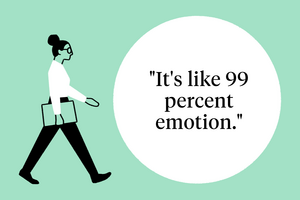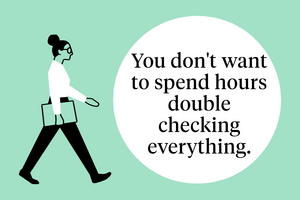Careers Jun 8, 2020
Exhausted by Working from Home? Anxious about Going Back?
Tips from a clinical health psychologist on managing the work-related stressors that may be affecting your mental health.

Michael Meier
Editor’s note: This is part of a series of articles based on Kellogg Executive Education webinars focused on COVID-19.
It likely won’t surprise you that therapists like Stephanie Ross have seen a huge increase in demand for counseling services this spring. She calls it the “most tremendous uptick” she’s seen in her career.
Each Thursday, Kellogg faculty are offering free webinars on how COVID-19 is impacting businesses, markets, and careers. You can sign up for upcoming sessions, hosted by Kellogg Executive Education, here.
Much of this demand is due to increased anxiety and depression, with people reporting trouble sleeping, an inability to concentrate, or an increased craving for alcohol and drugs.
And while many anxieties center on people’s health and safety, there is also a lot of worry about work, explains Ross, Ph.D., founder of Illness Navigation Resources and assistant clinical professor of psychiatry and behavioral sciences at Northwestern Medicine.
Essential workers and those who have lost jobs likely have very acute concerns right now. And those who are still working and doing so remotely have their own worries that can be driving anxiety, from the logistics of balancing work and homeschooling to worries about having to go back into the office.
Ross offered advice for this second group on managing many of these stressors during a recent webinar from Kellogg Executive Education.
For starters, Ross advises, make sure you are taking breaks. Many of the clients she sees in her practice are working much, much longer hours than they used to.
Some have “gone 12 hours without leaving their home office, or the closet in their home that they consider an office,” she says. Or, because of insomnia, “they’re awake anyway at 5 in the morning, so why not go back to work?”
In order to create clear work boundaries in the absence of a regular commute, she suggests turning the ringer and news alerts off on your phone during certain times of day; reinstating the lunch break you used to take; and even taking a vacation. Many people canceled vacations this spring and into the summer because they couldn’t go to their intended destination, says Ross. But working for months on end without a break is rarely sustainable. So consider taking time off, even if you have nowhere to go.
“It’s really important to have some separation from work and from thinking about work,” she says.
And people should carve out space, not just time, for themselves. With families on top of each other all day, every day, this can be hard. This may mean, she says, “being strict about locking a door when you may not have been a family that ever locked doors.”
Another common fear, particularly for those who have been working remotely for the past few months, is the anxiety around simply returning to the workplace. Are your coworkers practicing safe social distancing? What if your job means walking into other people’s homes or businesses? What if your job necessitates regular airplane travel?
She recommends that people start by assessing what their main concerns are. “Then cross-reference those with what are the places and what are the job requirements you have that may put you in a compromised position,” she says.
After you have a sense of that, it’s time to talk to your manager.
“It’s always better to bring your concerns to your manager up front,” she says. And then continue the conversation, because there are likely challenges that you haven’t thought of until you are in a particular situation.
“There are a lot of potential landmines that can happen that we just don’t know yet,” she says.
Another concern is what to do if you are worried about a colleague’s mental health, or even a supervisor’s?
“It’s always tricky to have a conversation with people about sensitive issues,” Ross says. “On many levels, it’s discouraged at workplaces.”
Ross says one way to start a dialogue is to take advantage of the question that kicks off most meetings these days: “How are you?” You don’t need to answer with your deepest, darkest secret, she says. Even just a nod to your state of mind can help. She recently answered such a question by saying she was “okay-ish,” which made the other person more at ease to discuss their worries. “It’s a way of forming a connection.”
On the organizational level, she encourages employers to regularly send out a list of employee-assistance resources, perhaps as often as once a week. This helps to normalize the idea of reaching out for help.
Overall, it’s important to remember that while the impact of COVID-19 has not been uniform, “we are all suffering in some way.” But, instead of focusing on what you have lost, try to think about what you are still able to do. Maybe that’s volunteering, or exercising, or starting a meditation practice.
“Prioritize activities that give you peace,” she says. “I really challenge people to ask, ‘what can you still do?’”
You can watch the full webinar here and can download Ross’ slides as well, which contain many resources for those experiencing anxiety or depression, including the National Alliance on Mental Illness helpline at 1-800-950-NAMI or text “NAMI” to 741741.
You can see previous articles from this series here.


